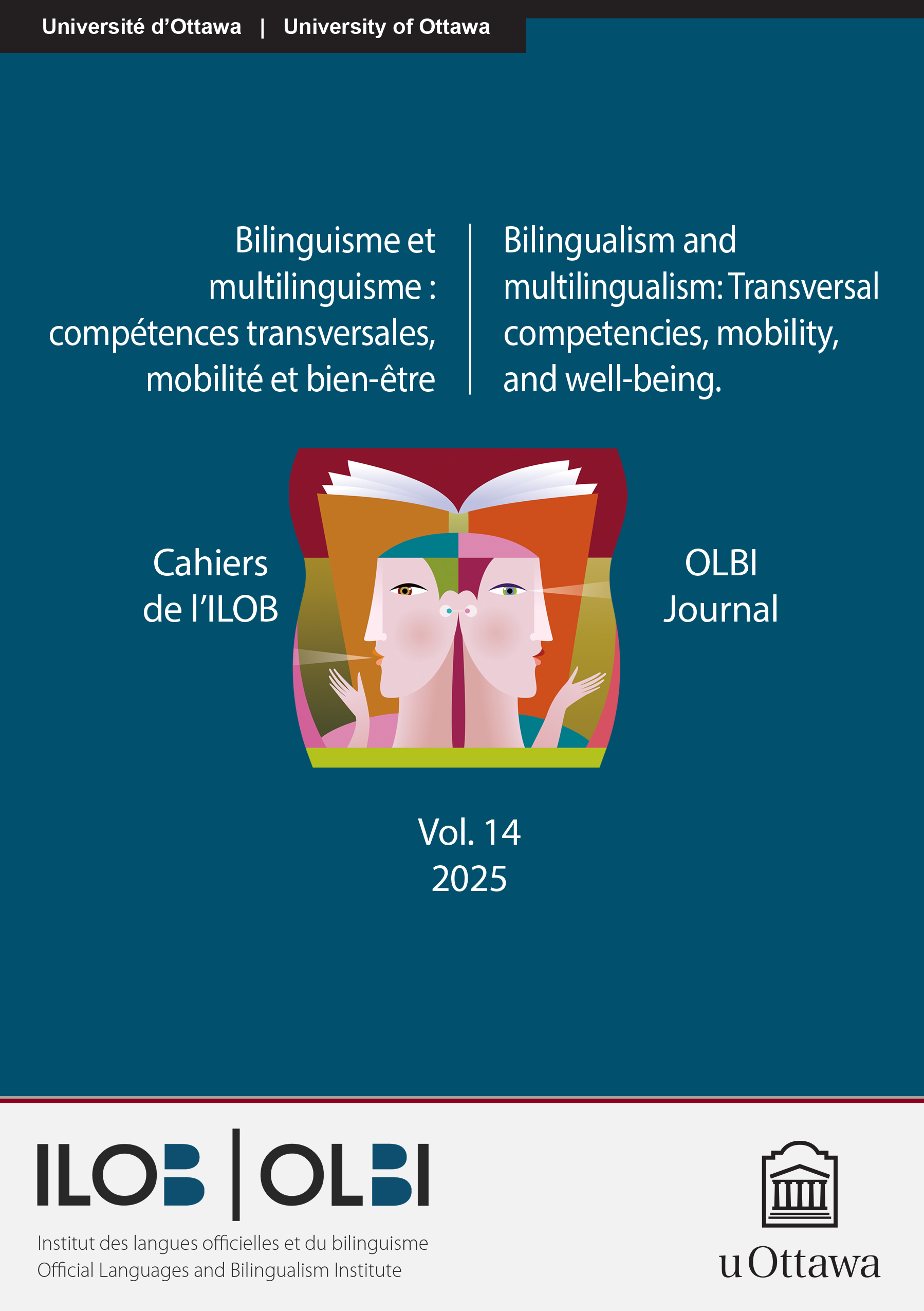L’accès à l’information pour les citoyens sourds québécois dans un contexte de multilinguisme et de diglossie
DOI:
https://doi.org/10.18192/olbij.v14i1.6899Keywords:
sign languages, accessibility, diglossia, language planning, legislation, disabilityAbstract
Focusing on the situation of deaf bilingualism in Canada, where sign languages (SLs) are in a situation of diglossia with respect to the official languages, we examine the role and status of SLs in accessibility policies and in Quebecers deaf citizens’ perceptions of equal access to information. Our analysis of deaf citizens’ perceptions and experience (7 focus groups, 13 interviews) shows that adequate accessibility is defined by i) the respect of political commitments, ii) the establishment of norms of accessibility involving free choice of language, iii) personal control of technical parameters, iv) the recognition of deaf expertise’s, and v) the requirement of training and qualification. This analysis reveals a dichotomy between the absence of language policies regarding canadian SLs and the Accessible Canada Act’s goal of eliminating obstacles to information accessibility.
References
British Sign Language (Scotland) Act 2015. (2015). Consulté le 22 juin 2023. https://www.legislation.gov.uk/asp/2015/11/contents/enacted
Confédération des organismes de personnes handicapées du Québec. (2017, juillet). Mémoire sur la Loi en matière d’accessibilité—Qu’est-ce qu’un Canada accessible pour vous ? Bureau de la condition des personnes handicapées. https://cophan.org/wp-content/uploads/2017/07/2017-07-11-MEM-COPHAN-canada-accessible.pdf
De Meulder, M. (2017). The influence of deaf people’s dual category status on sign language planning: The British Sign Language (Scotland) Act (2015). Current Issues in Language Planning, 18(2), 215–232. https://doi.org/10.1080/14664208.2016.1248139
Deschamps, C. (1993). L’approche phénomènologique en recherche : comprendre en retournant au vécu de l’expérience humaine. Guérin universitaire.
Dubuisson, C., & Nadeau, M. (1993). Études sur la langue des signes québécoise. Presses de l’Université de Montréal.
Higgins, P.C. (1979). Outsiders in a hearing world: The deaf community. Urban Life, 8(1), 3–22. https://doi.org/10.1177/089124167900800101
Lane, H. (1992). The mask of benevolence : Disabling the deaf community. Alfred A. Knopf.
Langevin, J., Rocque, S., Chalghoumi, H., & Ghorayeb, A. (2011). Rapport de recherche pour les milieux associatifs de Montréal—Accessibilité universelle et designs contributifs (version 5.3.) Université de Montréal.
Loi canadienne sur l’accessibilité. LC 2019, ch. 10.
Loi sur la diffusion continue en ligne. LC 2023, ch. 11.
Loubier, C. (2002). L’aménagement linguistique : fondements de l’aménagement linguistique [Ressource en ligne]. Office de la langue française. Collections de BAnQ. https://collections.banq.qc.ca/ark:/52327/46238
Ministère de la Santé et des services sociaux. (2007). L’accès aux documents et aux services offerts au public pour les personnes handicapées—politique gouvernementale. Direction des communications. https://publications.msss.gouv.qc.ca/msss/document-001156/
Office des personnes handicapées du Québec. (2012). Rapport sur l’organisation et la gestion des services régionaux d’interprétation visuelle et tactile. Service des relations publiques. https://bit.ly/OPHQ-2012-Rapport-organisation-services-interpretation
Office des personnes handicapées du Québec. (2019). Mise en oeuvre de la politique gouvernementale. L’accès aux documents et aux services offerts au public pour les personnes handicapées—Bilan 2010–2011 à 2016–2017. Secrétariat général.
Organisation des Nations Unies. (2006, décembre). Convention relative aux droits des personnes handicapées et Protocol facultatif. https://www.un.org/disabilities/documents/convention/convoptprot-f.pdf
Padden, C., & Humphries, T. (1988). Deaf in America: Voices from a culture. Harvard University Press.
Parisot, A.-M., & Rinfret, J. (2012). Recognition of langue des signes québécoise in Eastern Canada, Sign Language Studies, 12(4), 583-601.
Parisot, A.-M, Voghel, A., Gagnon, L., Hould, C., & Saunders, D. (2023, juin). L’information accessible pour les sourds et malentendants canadiens. Perception des citoyens sourds et malentendants, des interprètes et des diffuseurs. Groupe de recherche sur la LSQ et le bilinguisme sourd. https://lsq.uqam.ca/?q=content/linformation-accessible-pour-les-sourds-et-les-malentendants-canadiens-perceptions-des
Russell, D., McLaughlin, J., & Demko, R. (2018, mars). Barrier-free emergency communication access and alerting system. Research report. Canadian Hearing Society. https://bit.ly/CHS-Pilot-screening-Interpreting
Secrétariat du Conseil du trésor. (2018a). Modernisation des standards sur l’accessibilité du Web : démarche et principes directeurs de modernisation (SGQRI-008). https://bit.ly/Tresor-2018a-Modernisation-accessibilité-web
Secrétariat du Conseil du trésor. (2018b). Standard sur l’accessibilité des sites Web (SGQRI 008 2.0). https://bit.ly/Tresor-2018b-Standards-accessibilite-web
Société logique. (2012, mars). Accessibilité universelle : une nouvelle définition. Consulté le 11 août 2023. https://societelogique.org/2012/03/18/accessibilite-universelle-une-nouvelle-definition/
Tollefson, J. (1991). Planning language, planning inequality: Language policy in the community. Longman.
Turner, G.H. (2009). Sign language planning: Pragmatism, pessimism and principles. Current Issues in Language Planning, 10(3), 243–254. https://doi.org/10.1080/14664200903162505
Van Manen, M. (2023). Phenomenology of practice: Meaning-giving methods in phenomenological research and writing. Routledge.
World Wide Web Consortium. (2009, juin). Web content accessibility guidelines (WCAG) 2.0. Consulté le 11 août 2023. https://www.w3.org/Translations/WCAG20-fr/
World Wide Web Consortium. (2021, avril). Sign languages in making audio and video media accessible.
Downloads
Published
Issue
Section
License
Copyright (c) 2025 Anne-Marie Parisot, Amélie Voghel

This work is licensed under a Creative Commons Attribution 4.0 International License.
Authors who publish with OLBI Journal agree to the following terms:
- Authors retain copyright and grant the OLBI Journal (OLBIJ) right of first publication with the work simultaneously licensed under a Creative Commons Attribution License that allows others to share the work with an acknowledgement of the work's authorship and initial publication in the OLBIJ.
- Authors are able to enter into separate, additional contractual arrangements for the non-exclusive distribution of the OLBIJ's published version of the work (e.g., post it to an institutional repository or publish it in a book), with an acknowledgement of its initial publication in the OLBIJ.
- Authors will not simultaneously submit the same piece of work for possible publication to more than one academic journal at a time.


